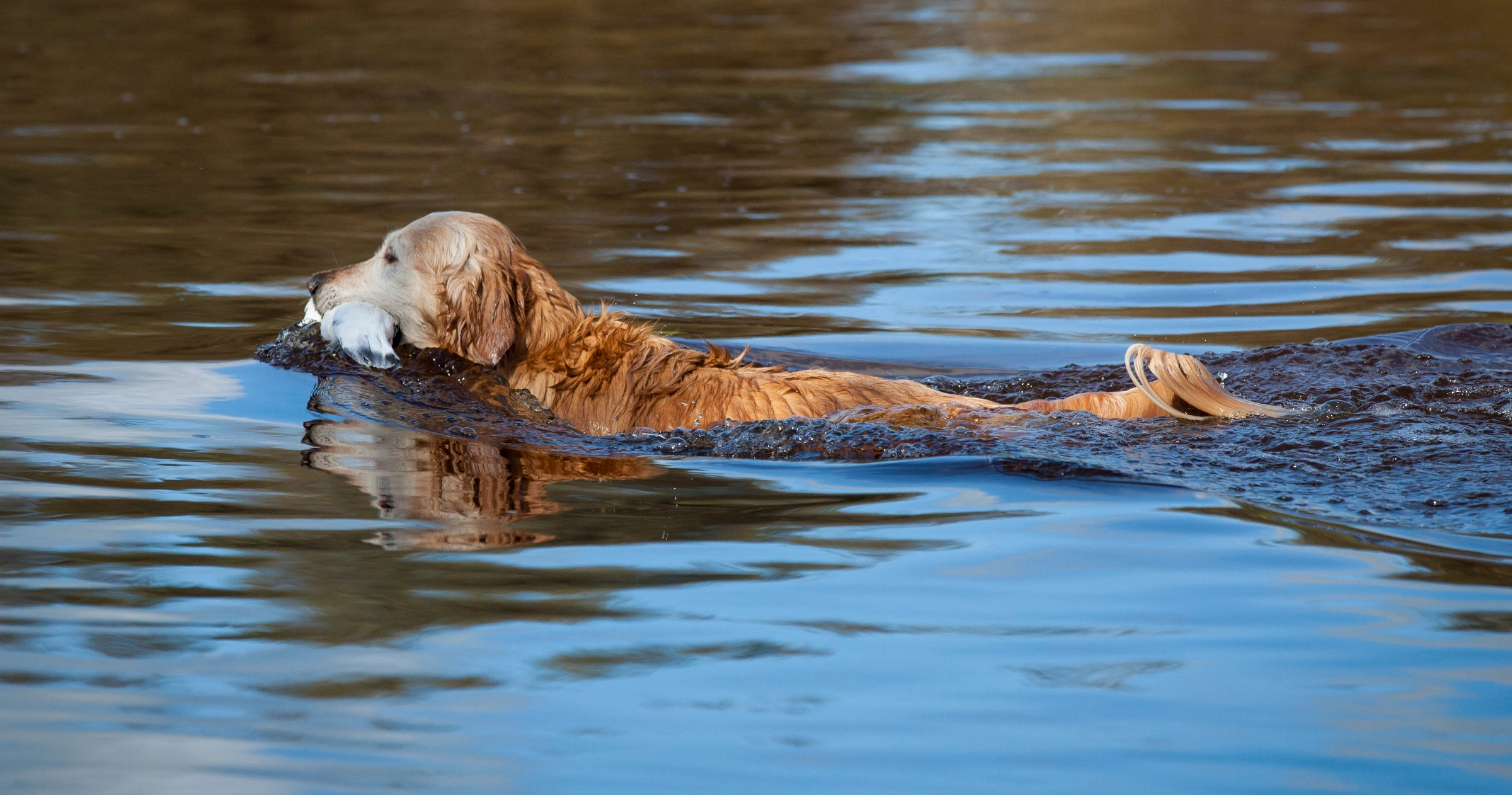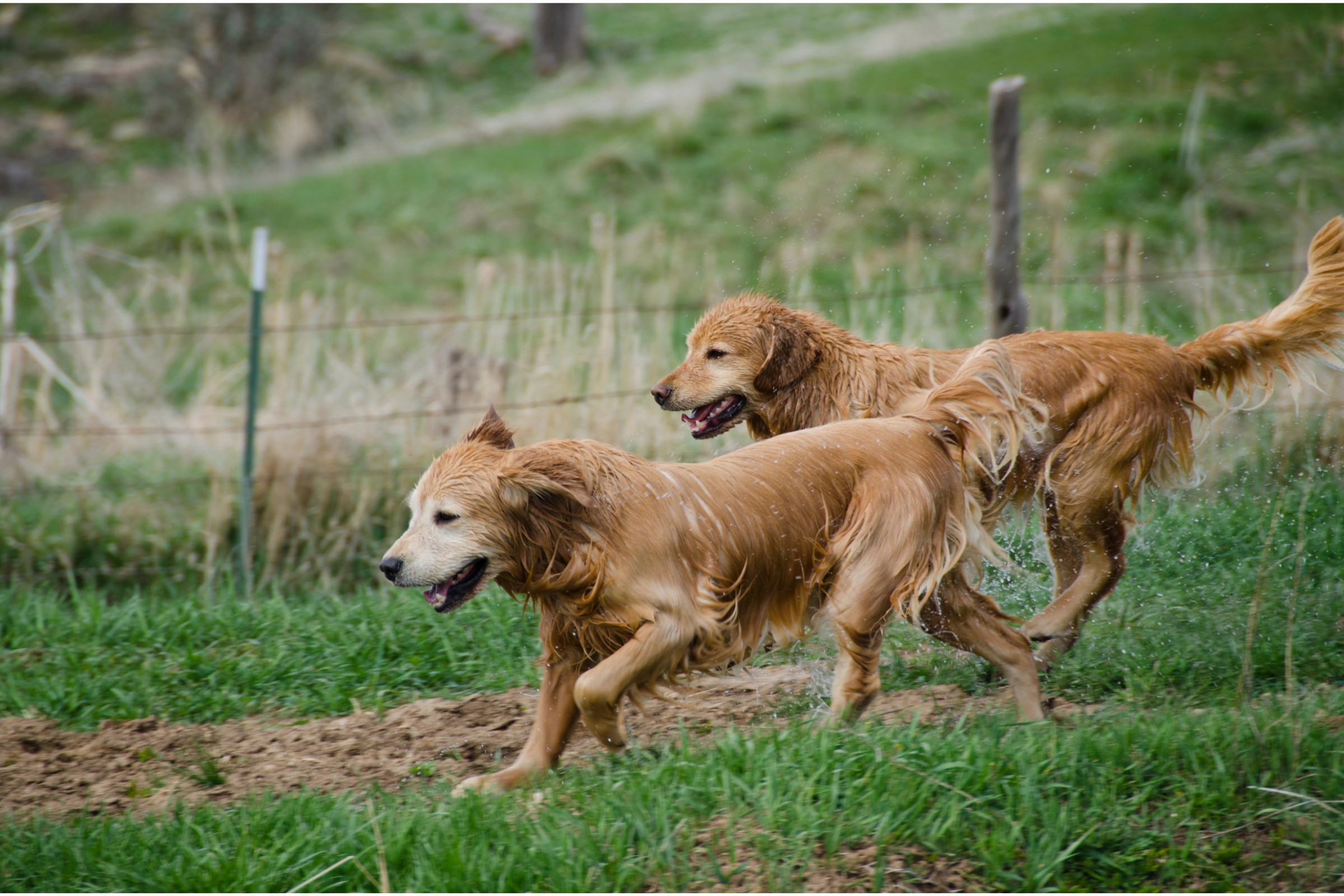This post may contain ads and affiliate links and we may earn a small commission when you click on the links at no additional cost to you. As an Amazon Affiliate, we earn from qualifying purchases. You can read our full disclaimer here.
Golden Retriever Prey Drive: Myths, Realities, and Tips for Owners

When discussing the Golden Retriever prey drive, many eyebrows rise in surprise.
After all, these dogs are best known for their friendly demeanor and lovable, goofy personalities. It’s easy to think, “My Golden? Having a prey drive? Nah!”
But, let’s hit the brakes for a moment and dive a bit deeper.
Understanding the Golden Retriever Prey Drive
Golden Retrievers, like all dogs, have roots that trace back to wild ancestors. Despite their reputation as family-friendly pets, there are some misconceptions about their innate behaviors.

The idea that Golden Retrievers don’t possess any prey drive is one of these myths. Sure, they’re not the most aggressive hunters out there, but that doesn’t mean the instinct isn’t lurking somewhere beneath those golden locks.
So, where did this myth originate? Maybe it’s their gentle approach to life or their seemingly endless patience with kids and other pets.
Either way, it’s essential to separate fact from fiction and truly get to know our furry friends for who they are.
What is Prey Drive? Let’s Define It
At its core, prey drive is an instinctual behavior. It’s that compelling urge a dog feels to chase moving objects, be they fluttering leaves, darting squirrels, or even a jogger going by.
Simply put, it’s a dog’s natural inclination to hunt and pursue, even if they don’t necessarily follow through with the catch.
The Evolutionary Role in Dogs
Diving back into canine history, dogs descended from wolves. These wild ancestors relied heavily on their prey drive to survive. Hunting wasn’t a game; it was a necessity.
The stronger the drive, the higher the chances of a successful hunt, and thus, survival.
Fast forward to domesticated dogs, and while many no longer need to hunt for their dinner, the remnants of this drive still exist. It has been shaped and molded over generations depending on the role each breed played.
Herders might chase to corral, retrievers might chase to fetch, and so on. For our beloved Goldens, this means that while they may not have the intense drive seen in some breeds, the instinct to chase and play still lingers in their DNA.
The Evolutionary Background of Golden Retriever Prey Drive
Let’s rewind the tape to the mid-19th century, Scotland. Here, amidst scenic highlands and expansive estates, the story of Golden Retrievers begins.
They were born from a blend – the now-extinct Yellow Retriever and the Tweed Water Spaniel. Later, a dash of Bloodhound, Irish Setter, and more were mixed in to refine the breed.
Roles They Were Born For

Golden Retrievers were originally bred for a pretty cool job – retrieving! The Scottish elite loved hunting, especially waterfowl. But with Scotland’s rugged terrain and plenty of wetlands, they needed a dog that was not only keen on fetching game but also had a love for water. Enter the Golden Retriever.
- Strengths of a Golden:
- A soft mouth (meaning they can carry things without biting hard).
- Stellar swimming skills.
- A friendly and trainable nature.
Golden Retriever Prey Drive: Born from Necessity?
So, how does this history influence the Golden Retriever prey drive? Their ancestors were not predators per se but retrievers. They chased and fetched, yes, but always with the goal to bring the game back undamaged.
It wasn’t about the hunt, but the retrieve.
This might explain why many Goldens today might give a playful chase or pick up a creature gently, much like a child showing off a newfound toy, without the intense drive to “hunt” in the traditional sense.
Common Behaviors that Indicate Prey Drive in Dogs

Dogs, with their diverse personalities and instincts, often display a range of behaviors that hint at their ancestral roots. Identifying these behaviors can provide insights into their natural inclinations, particularly when it comes to the age-old instinct of prey drive.
The Chase, The Stalk, and The Mouth: A Dog’s Trio of Tells
When it comes to understanding our four-legged friends, observing their behavior can give us a wealth of information. It’s like decoding a secret language, revealing hints about their inner instincts and drives.
1. The Chase is On!
Nothing beats the thrill of a chase, at least in a dog’s world. Whether it’s the fleeting squirrel, a zooming car, or that unsuspecting neighborhood jogger, moving objects are just too tempting for our pups to resist.
This chase instinct stands as one of the primary indicators of prey drive. Whenever something zips by, those canine reflexes kick in, and off they go!
2. The Stealthy Stalk
Beyond the outright chase, there’s a more subtle behavior: stalking. It’s the hunkering down, the slow and deliberate moves, all reminiscent of wild predators.
While your living room might be far from the wild plains, the heart of the hunter beats strong in many a pet.
Common stalking targets include:
- Toys waiting to be pounced on.
- Other pets, especially the unsuspecting cat lounging in the sunbeam.
- Random shadows or lights, moving ever so slightly.
3. Mouth Matters: From Gentle Grabs to Nippy Nibbles
Lastly, there’s the mouth. Dogs use their mouths like we use our hands – to explore, play, and sometimes, show off. The nature of this “mouthiness” can be a huge tell about their prey drive.
Types of mouth behaviors:
- Gentle carrying, like a retriever with a prized toy.
- Playful nipping during games.
- Aggressive biting or tearing, especially during play.
Analyzing the Golden Retriever’s Prey Drive
Golden Retrievers, often hailed for their gentle disposition, have a spectrum of behaviors rooted in instinct and history.
Unpacking this spectrum can shed light on their underlying prey drive, offering insights for both seasoned and new Golden owners.
Check out our post about leaving Golden Retrievers alone.
Golden Observations: What Owners Notice
Golden Retrievers, with their affable nature and wagging tails, often present a demeanor that’s far from the image of a hunter.
Yet, many owners have tales of their Goldens getting distracted by a fleeting butterfly or giving a playful chase to a backyard squirrel. These moments, while often lighthearted, are small windows into their inherent prey drive.
Experts Weigh In
While individual stories are enlightening, turning to research provides a broader perspective. According to various canine experts, the prey drive in Golden Retrievers is generally considered moderate. They were, after all, bred to retrieve game without harming it.
This means that while they have the instinct to chase and catch, they don’t possess the intense drive to “hunt” or harm like some other breeds might.
Key Expert Findings:
- Goldens often exhibit a “soft mouth,” indicative of their retrieving roots.
- Their prey drive is typically more playful than predatory.
- Training and early socialization play a huge role in moderating their chasing behaviors.
Every Golden is Unique

Just as humans have varied personalities, so do our furry friends. Some Goldens might have a barely noticeable prey drive, being more couch potato than chaser. Others might find it hard to resist a brisk pursuit of a rolling ball or darting critter.
It’s essential for owners to recognize that the intensity of the prey drive can vary widely among individual Golden Retrievers, making each one’s behavior a unique blend of nature and nurture.
Personal Experience of a Golden Retriever’s Prey Drive: A Gentle Chase
Every dog owner has tales that encapsulate the essence of their pet’s personality. For my Golden Retriever, Daisy, it’s the stories of a gentle interaction with a baby rabbit and a whimsical chase with a squirrel that truly highlight her playful and benign prey instincts.
The Day of the Baby Rabbit
One sunny afternoon, a scene unfolded that showcased the unique nature of my Golden Retriever’s prey drive. As she frolicked around our garden, her attention was suddenly caught by something small and furry: a baby rabbit.
With the utmost gentleness, she picked it up in her mouth, displaying that iconic “soft mouth” retrievers are known for.
I watched, heart in throat, but to my relief, when I asked her to drop it, she did so instantly, looking up at me with those soulful eyes as if saying, “Look what I found for you!”
Squirrel Playtime
Then there is the squirrel saga. Daisy has this amusing habit: every time she spots a squirrel in the backyard, it’s game on.
But here’s the twist – she doesn’t really want to catch it. It’s like a playful dance. She runs, but always at the same casual pace as the squirrel, as if they’ve both silently agreed it’s just for fun.
The chase never has a victor; it’s all in good sport, showcasing her more playful side rather than a serious prey instinct.
Managing and Understanding Your Golden Retriever’s Prey Drive
Embracing a Golden Retriever’s innate behaviors while ensuring they navigate the world safely is a dance every owner learns over time.
Unpacking the nuances of their prey drive and implementing strategies to manage it can lead to happier dogs and more relaxed outings.
Recognizing the Signs: The First Step
Awareness is pivotal. Before you can manage your Golden’s prey drive, it’s essential to recognize its signs. By being observant and understanding their unique behaviors, you’ll be better equipped to respond appropriately, ensuring their safety and that of other animals around them.
Productive Techniques for a Happy Golden
Addressing and channeling your Golden’s prey drive doesn’t mean curbing their enthusiasm. Instead, it’s about directing that energy in ways that are fun, safe, and fulfilling for them.
Here’s how you can manage it effectively:
- Command Training: Teach them valuable commands like “Leave it” or “Drop it.” This not only helps in potential prey drive situations but also ensures they listen to you in various circumstances.
- Controlled Play Zones: Ensure your dog plays in safe and controlled environments. A fenced backyard or a leash in open spaces can prevent sudden sprints towards distractions.
- Alternative Stimulation: If your Golden loves to chase, why not turn it into a game? Fetch or tug-of-war can be great ways to engage them. Moreover, puzzle toys or scent-tracking games can provide mental stimulation, satisfying their instincts without the chase.
Tips for Potential Golden Retriever Owners
Embarking on the journey of owning a Golden Retriever is filled with moments of joy, laughter, and some natural canine behaviors.
If you are preparing to welcome this loving breed into your home, understanding their quirks and instincts can pave the way for a harmonious bond.
Knowing What’s in Store
Golden Retrievers are more than their adorable faces and gentle dispositions. While they’re renowned for their friendly nature, potential owners should be aware of their inherent instincts and behaviors.
This isn’t a sign of them being ‘problematic’; it’s merely a testament to their rich history and lineage.
Preparation is Key
Awareness prepares you for reality. Here are some typical Golden behaviors to anticipate:
- A sudden urge to chase after moving objects, be it a playful squirrel or a falling leaf.
- Moments of curiosity where they might pick up things with their mouth – often without the intention of harm.
- An inquisitive nature, always ready for the next adventure.
Early Training: The Golden Ticket
Golden Retrievers are eager learners, especially when they’re young. Here are some tips to make the most of this:
- Start training sessions early. Young pups are adaptable and can pick up commands swiftly.
- Socialize them with various environments and people. This helps in building their confidence.
- Positive reinforcement is key. Always reward good behavior, making the learning process a joyful one for them.
The Wrap Up to Golden Retriever Prey Drive
Golden Retrievers, known for their warmth, loyalty, and undeniable charm, also come with a palette of natural instincts, including the often-misunderstood prey drive.
Through our exploration, we’ve uncovered the roots of this behavior, ranging from their evolutionary history to individual tales of whimsical chases.
It’s vital for owners, both current and potential, to perceive this prey drive not as a flaw but as a facet of their dog’s rich tapestry of behaviors.
Recognizing these instincts, coupled with the right training techniques, can channel this drive productively, ensuring that your Golden remains both stimulated and safe.
At the heart of it all, understanding and respect for our furry friends’ natural tendencies will only strengthen the bond we share, fostering a relationship built on mutual trust and love.
-

Coffee Mug – In Dog Coffees I’ve Only Had One
$11.95 – $14.95 Select options This product has multiple variants. The options may be chosen on the product page
